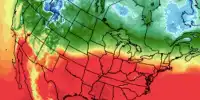More than a billion years of geological history is missing from some parts of the Grand Canyon and some geologists believe, much of the rest of the world. A new investigation into this mysterious interval of time, which has puzzled geologists for 152 years, is responsible for the separation of the supercontinent Rodinia 700 million years ago. Northern Arizona rocks have accumulated over the past two billion years. The Colorado River has exposed these layers because it has carved its way downwards, and therefore returned in time.
However, a huge swath is missing for many parts of the length of the canyon, where rocks from one era long ago were piled directly on top of the rock, a feature known as “inconsistency”. The inconsistencies are common, but what Grand Canyon reveals is so vast that it was named the “Great Inconsistency” after it was discovered in 1869, and geologists have been confused ever since. The new evidence presented in geology provides explanations using differences along the length of the canyon.
The appropriately named Barra Peak, a student at the University of Colorado, Boulder, said in a statement, “The Great Inconsistency is one of the first well-documented geological features in North America.” “But until recently, we didn’t have much of an issue about when or how it happened.” Mysteries have deepened since the same era as other inconsistencies have been discovered elsewhere in the world. Some geologists believe that these are connected; they are responsible for the huge glaciers known as Snowball Earth that empties the empty rocks.
Others think it is nothing more than a random event, some of which inevitably coincides with time. Rodinia covers most of the world’s continents, but the separation began about 800 million years ago and accelerated later. Pick argues that Rodinia’s great divorce now leads to violent convictions in the vicinity of the Canyon region. The rocks were pulled upwards and came in contact with the elements, eventually being washed into the sea.
While many geologists have studied inconsistencies without concluding, something different had to be done for Peak. He and his co-authors considered the fact that excess layer pressure heats rocks, initiating chemical reactions that create records of past temperatures, a process known as thermochronology. By measuring the spread of helium from ancient rocks, the authors conclude that the history of temperatures east and west of the canyon is quite different.
















